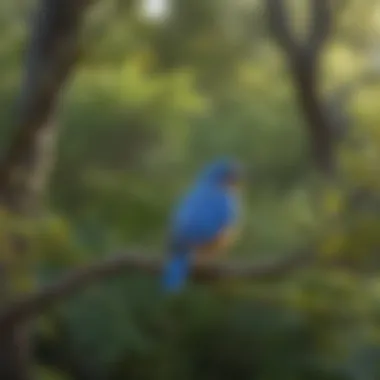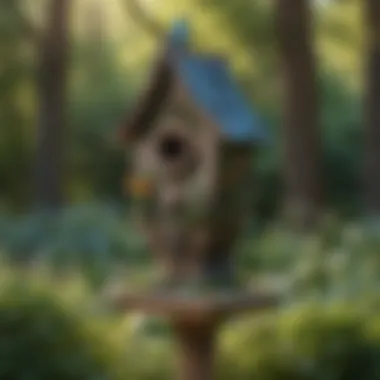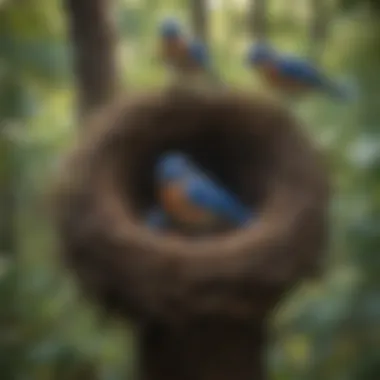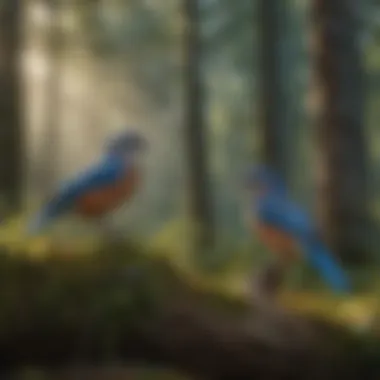Understanding Blue Birds and Bird Houses


Intro
The importance of ensuring suitable habitats for various wildlife cannot be overstated. In particular, blue birds serve as significant indicators of environmental health. Understanding their needs can help guide practices in wildlife conservation and sustainable living. This article focuses on the relationship between blue birds and bird houses, detailing essential aspects for creating effective avian habitats.
Understanding Forestry Practices
A deep dive into forestry practices reveals their impact on bird populations. These practices directly influence the availability of natural housing for blue birds, among other species. Responsible forestry supports biodiversity, reduces habitat loss, and maintains ecosystem balance.
Types of Forestry Practices
There are several fundamental practices in forestry that affect wildlife habitats. These include:
- Sustainable Forest Management: This practice emphasizes long-term health of forests rather than short-term gains. It includes actions that prevent overharvesting wood resources.
- Selective Logging: Instead of clearing entire areas, this method involves harvesting only certain trees. This approach helps protect the surrounding ecosystem and maintains the habitat for blue birds.
- Reforestation: Planting trees after logging is crucial for restoring habitats. It ensures that blue birds have safe nesting sites as forests regenerate.
Historical Context
Historically, many ecosystems have suffered due to mismanagement of forestry practices. Early industrial logging led to habitat fragmentation and decline in blue bird populations. Understanding this history is vital for forest managers today as they work to implement practices that promote sustainability and support wildlife.
Principles of Woodland Stewardship
Effective woodland stewardship is crucial for maintaining biodiversity in forest ecosystems. This approach goes beyond merely managing land; it requires an understanding of the delicate balance between human activities and nature.
Conservation Techniques
Conservation techniques are essential in promoting thriving habitats for blue birds. Some key methods include:
- Habitat Restoration: This involves reviving areas that have been degraded by human activity. By restoring native vegetation, blue birds can find suitable nesting sites.
- Monitoring Wildlife: Keeping track of blue bird populations allows conservationists to detect changes over time. This data informs management decisions in real time.
Managing Forest Resources
Proper forest resource management ensures that blue birds can thrive within their environments. This entails:
- Implementing practices that are environmentally sound and sustainable.
- Engaging local communities to promote awareness and participation in conservation efforts.
Sustainable Forest Management
The essence of sustainable forest management lies in its potential benefits, not just for wildlife but also for communities. It is increasingly recognized as an necessary approach to maintaining ecological balance.
Certification Standards
Various certification standards, such as the Forest Stewardship Council, provide guidelines for sustainable practices. These standards reassure consumers of responsible sourcing, encouraging behavior that favors the well-being of blue birds.
Economic Benefits of Sustainability
Investing in sustainable practices can have significant economic returns. Managing forests sustainably often leads to increased tourism opportunities and improved ecosystem services. Healthy forests provide resources such as clean water and air, which benefit both wildlife and people.
“Sustainable forestry is not just a conservation issue, but an economic imperative.”
Preamble to Blue Birds
Blue birds are a vital part of many ecosystems, serving not only as indicators of environmental health but also enhancing biodiversity. This section will cover the key elements concerning blue birds that are essential for understanding their role in natural habitats.
Their beauty and song attract bird watchers, making them significant in promoting conservation efforts. Understanding blue birds allows us to appreciate their behavior, habitats, and how best to support their populations through sustainable practices.
Characteristics of Blue Birds
Blue birds, primarily known for their vibrant plumage, show a variety of sizes and adaptations. Their coloration can vary, but the blue hues often signify a healthy and well-adapted species. Most blue birds possess a strong flight ability, which aids in their survival against predators. They are predominantly insectivorous, adjusting their diet according to seasonal availability. Moreover, they exhibit complex social behaviors, often forming flocks during migration, which contributes to their resilience in diverse environments.
Species Overview


Eastern Bluebird
The Eastern Bluebird is well known for its striking cobalt blue back and warm reddish-brown chest. This species is a popular choice for bird enthusiasts due to its gentle demeanor and melodious song. Its preference for open fields and perches makes it particularly responsive to provided birdhouses, which can support its nesting habits.
A unique feature of the Eastern Bluebird is its ability to adapt to human-altered environments. This adaptability can be advantageous in areas with suitable housing available, thus enhancing its population in regions where natural cavities are scarce. However, they face challenges from competitive species and habitat loss, making conservation measures crucial for their long-term survival.
Western Bluebird
The Western Bluebird showcases a more muted palette with its azure and chestnut coloring. This species favors shrublands and open woodlands, contributing to pest control through its insectivorous diet. It is beneficial for gardeners and farmers, providing natural pest management in cultivated areas.
Western Bluebirds often nest in tree cavities, but they readily accept artificial nest boxes, which can promote their population in suburban and rural settings. While they share common challenges like habitat loss, their social behavior during breeding can lead to more successful nesting when suitable sites are provided.
Mountain Bluebird
Mountain Bluebirds are known for their striking blue color and preference for open habitats in higher elevations. They play a key role in controlling insect populations in alpine meadows. Their migration patterns tend to be slightly different compared to their eastern and western counterparts, as they often move to lower elevations during the winter months.
A unique trait of Mountain Bluebirds is their tendency to often forage alone, which can limit their social interactions outside of breeding. While this isolation can be disadvantageous in terms of social structure, their preference for open spaces makes them easier to attract into human-designed habitats.
Geographical Distribution
Blue birds are found across North America, with varying species occupying different habitats. The Eastern Bluebird is primarily found in the eastern regions, while the Western Bluebird inhabits the western states. Mountain Bluebirds are usually present in higher elevations, and their distribution varies with season.
Understanding the geographical spread of blue birds is critical in addressing their conservation needs. Their dependence on specific habitats means that changes in land use or climate can significantly impact their populations. Therefore, informed efforts in habitat preservation and restoration are essential.
Behavioral Ecology of Blue Birds
Understanding the behavioral ecology of blue birds is essential for several reasons. It offers insights into their survival strategies, reproductive success, and interactions within their ecosystems. By studying these behaviors, conservationists can better design interventions that support both blue birds and their habitats, fostering a healthier ecosystem overall.
Nesting Habits
Blue birds exhibit specific nesting habits crucial to their reproduction. Typically, females choose nesting sites within tree cavities, shrubs, or specially designed bird houses. The materials used for nests often include grasses, feathers, and built-in materials like dried mud. These materials provide insulation and protection for eggs and chicks. The selected location can significantly impact the success rate of chick survival, highlighting the importance of appropriate bird house design to mimic natural nesting environments.
Nesting occurs in spring, aligning with the availability of food resources. Females generally lay between three to six eggs per clutch. After hatching, both parents take an active role in feeding and protecting the young. Knowing these habits enables conservationists to create better environments and support blue bird populations effectively.
Feeding Patterns
Blue birds primarily feed on insects, worms, and berries, depending on the season. These feeding habits adapt according to availability and nutritional needs. Insects form a significant part of their diet, particularly during the breeding season, as they provide essential protein for growing chicks.
Berries become more prominent in their diet as the season progresses into late summer and fall. Understanding this feeding behavior is critical for habitat management. Providing food sources throughout the year can aid in sustaining blue bird populations. Ensuring that they have access to both insects and berries can support their nutrition and reproductive success, emphasizing their reliance on healthy ecosystems.
Migratory Trends
Migratory trends in blue birds show their adaptability to changing environmental conditions. Depending on the species, blue birds may migrate short or long distances during the fall and spring. For example, Eastern Bluebirds typically migrate south during colder months and return to their breeding grounds as temperatures rise.
Migration timing relates to several factors including weather conditions and food availability. Understanding these trends is crucial for conservation efforts. Protecting migratory routes and wintering grounds can significantly contribute to the preservation of blue bird populations. International cooperation is often necessary to safeguard these habitats across different regions.
"Understanding the behavioral ecology of blue birds not only helps us protect their populations but also enriches our knowledge of ecological health."
The Role of Bird Houses
Bird houses play a significant role in supporting bluebirds and other avian species, particularly in the context of habitat requirements and the challenges posed by modern landscapes. As natural habitats diminish due to human development, these structures provide crucial nesting sites that facilitate reproductive success for bluebirds. Bird houses not only offer shelter but also contribute to the ecological stability of our environments by enhancing biodiversity. By ensuring that the needs of these birds are met, we support the broader ecosystem that they are a part of.
History and Evolution of Bird Housing
Bird houses have a rich history that dates back centuries. First used by farmers and landowners to attract beneficial bird species, their design has evolved remarkably over time. Early versions were simple wooden boxes, often discarded or repurposed materials. Over the years, more research into avian behavior led to the creation of bird houses with specialized features, tailored to the specific nesting habits of various birds, including bluebirds. This evolution reflects a growing understanding of how artificial structures can mimic natural nesting sites, improving survival rates and contributing to conservation efforts.
Types of Bird Houses
Natural Nesting Sites


Natural nesting sites refer to areas where bluebirds and other birds typically find shelter and raise their young. These can include cavities in trees, shrubs, or even cliff ledges. The key characteristic of natural nesting sites is their ability to mimic a secure environment. This makes it a popular choice for birds as it provides safety from predators. Unique features of these sites often include natural camouflage, which helps in hiding from threats. However, natural sites can be limited in availability due to urbanization and habitat loss, creating the need for artificial options.
Artificial Nest Boxes
Artificial nest boxes have gained popularity as human-made replicas of natural sites. They are beneficial as they provide specific dimensions suited for bluebirds and can be strategically placed in areas with high bird activity. Their unique feature lies in the ability to customize them for species-specific needs. However, one disadvantage is maintenance; improper upkeep can make these boxes unsuitable for use. Therefore, regular monitoring is required to ensure health and safety for the inhabitants.
Specialized Bluebird Houses
Specialized bluebird houses are designed explicitly for the needs of bluebirds. They often feature dimensions, entrance holes, and ventilation specific to bluebird behavior. This is important as it encourages bluebirds to use these houses, thus supporting their population. The key characteristic of these houses is their optimized design that offers safety and accessibility. The unique feature of specialized bluebird houses is that they are often constructed from durable materials, which increases their lifespan in outdoor conditions. However, they may be less flexible compared to general-purpose bird houses, limiting their use for other species.
Importance in Ecosystem
Bird houses are integral to maintaining the balance within ecosystems. By providing suitable nesting sites, these structures promote breeding and survival of species like bluebirds, which in turn control insect populations and contribute to plant pollination. The availability of nest houses can significantly enhance local biodiversity, creating a more resilient ecosystem. With increasing human impact on natural habitats, understanding the role of bird houses becomes crucial in fostering connections between nature and human communities.
Designing Effective Bird Houses
Creating a suitable habitat for blue birds requires careful consideration of various design elements in bird houses. An effective bird house is not just a shelter; it plays a crucial role in the health and well-being of avian populations. Proper design can impact nesting success, predator avoidance, and overall bird safety. Each design decision can either enhance or hinder the chance for blue birds to thrive.
Materials Selection
The choice of materials is paramount when designing bird houses. The structure must be durable enough to withstand weather conditions yet not harmful to the birds. Common materials include wood, recycled plastics, and natural materials like bamboo. Wood is often preferred, particularly cedar or pine, due to its durability and natural insulating properties.
Considerations for material selection include:
- Non-toxic options: Ensure materials are free from harmful chemicals.
- Insulation properties: Select materials that help regulate temperature.
- Durability: Aim for woods that resist rot and insect damage, reducing maintenance.
Dimensions and Measurements
Dimensions directly affect blue birds’ comfort and security in bird houses. The entrance hole size, internal space, and overall height must cater to blue birds' preferences. For instance, Eastern bluebirds typically favor slightly larger entrance holes compared to other species. Here are some key dimensions to consider:
- Entrance hole diameter: Generally between 1.5 - 2 inches for bluebirds.
- Interior floor dimensions: Should provide at least 6 x 6 inches of space.
- House height: Recommended around 8 to 12 inches to keep it safe from predators.
Ventilation and Drainage
Proper ventilation and drainage are essential to maintain a healthy environment within the bird house. Poor air circulation can lead to overheating and a buildup of harmful gases. Good drainage ensures that rainwater doesn’t accumulate and create a damp environment, which can foster mold and disease.
To facilitate ventilation and drainage:
- Drill small holes near the top of the house for air exchange.
- Incorporate drainage holes in the floor to allow water escape.
- Use sloped roofs to encourage water runoff.
Predator Proofing Techniques
Protecting blue birds from predators is a critical aspect of bird house design. Predation is a significant threat to nesting success. Implementing specific technologies and techniques can mitigate these risks.
Consider the following predator proofing methods:
- Use of baffles: Install metal or PVC baffles on poles to prevent climbing predators.
- Secure attachment: Ensure bird houses are securely fixed to avoid topple during wind.
- Avoid excessive height: Position the bird house at a safe height to deter many ground predators.
"Effective design elements not only enhance aesthetics but also contribute to the long-term welfare of blue birds."
Sustainable Bird House Practices
Sustainable bird house practices are crucial for creating safe habitats for blue birds. By leaning towards eco-friendly methods, we not only support blue bird populations but also promote overall forest health. These practices consider various elements such as material choice, placement, and ongoing maintenance. Emphasizing sustainability ensures that the habitats we build do not disrupt the environment and instead enhance biodiversity.
Eco-Friendly Materials
Using eco-friendly materials for bird houses minimizes environmental impact. Recycled or sustainably sourced wood is preferred, as it reduces the need for new timber. Plywood from certified manufacturers like the Forest Stewardship Council can also be an excellent choice. Additionally, untreated wood should be used, as preservatives and finishes may harm birds. Natural alternatives, such as bamboo or even the creative use of recycled plastic materials, can also offer durability while being kind to the ecosystem.
Placement and Location


The proper placement of bird houses plays a significant role in their effectiveness. It is essential to position the houses away from heavy human traffic and predators. Locations should provide adequate shelter from harsh weather and direct sunlight. Generally, placing houses at least five feet off the ground can help. The proximity to food sources—like berry-bearing shrubs or open fields—will attract blue birds. Observing local blue bird behavior and habitat preferences can guide decisions on where to position houses.
Maintenance and Cleaning
Regular maintenance and cleaning of bird houses are vital for sustaining healthy populations. It is advisable to check these structures at least once a year, ideally after migration seasons. Removing old nesting materials and assessing for damage keeps homes safe and inviting. So, cleanliness is paramount. Routine inspections can help identify early signs of disease or pest infestations. Using non-toxic cleaning methods helps ensure the health of the birds. It is also advisable to keep records of maintenance efforts to monitor changing bird patterns.
"Sustainable bird house practices foster not only the blue birds’ well-being but also contribute positively to local ecosystems."
The Impact of Human Activity
The dynamics between human activity and the environment are increasingly critical in discussions about wildlife conservation, particularly regarding blue birds and their habitats. Urbanization, agriculture, and industrial expansion present challenges that significantly disrupt the ecological balance blue birds rely on. Understanding these impacts is essential for preserving avian diversity and ensuring blue birds can thrive in changing landscapes.
Urbanization and Habitat Loss
Urban growth poses a severe threat to natural habitats. As cities expand, the fragmentation and destruction of forests lead to decreased nesting sites and foraging areas for blue birds. Urbanization results in:
- Loss of Natural Habitat: The conversion of woodlands and fields into urban landscapes reduces available living space for blue birds.
- Increased Pollution: Urban areas often contribute to air and noise pollution, affecting the health and behaviors of avian populations.
- Road Kill and Traffic: Increased traffic leads to higher mortality rates among birds, particularly near roads.
This habitat loss is not just about losing trees but encompasses the entire ecosystem that supports blue birds. Consequently, conservation strategies must address these urban pressures to create sustainable environments for birds.
"Human interference can have cascading effects in ecosystems, especially on species with specific habitat requirements like blue birds."
Conservation Efforts
In light of these challenges, targeted conservation initiatives become even more critical. These efforts include:
- Habitat Restoration: Programs to restore native plants and ecosystems can provide blue birds with necessary resources. Planting local vegetation can help to re-establish natural habitats lost to urbanization.
- Urban Planning: Incorporating green spaces in urban designs can mitigate habitat loss. Initiatives such as green roofs and community gardens create new habitats within cities.
- Monitoring Programs: Citizen science initiatives help track changes in blue bird populations. Engaging people in data collection raises awareness and fosters a conservation ethic among communities.
- Legislation: Local and national policies that protect natural habitats from further development are crucial. Enforcements of protected areas ensure some environments remain untouched by human encroachment.
Each of these strategies focuses on not just survival but also on enhancing resilience among blue bird populations confronted by human impacts. Sustainable approaches integrate thoughtful practices to harmonize human needs with the natural world.
Evaluating Avian Health
Evaluating avian health is essential in understanding the overall well-being of blue birds and their habitats. Health issues in bird populations can lead to declines, which can ultimately affect forest ecosystems. The study of avian health encompasses a range of factors, from disease management to the assessment of environmental impacts. Identifying health issues early allows for timely intervention, ensuring that both individual birds and populations thrive. Additionally, the connection to bird houses and sustainable practices plays a crucial role in promoting a healthier avian community.
Common Health Issues
Blue birds can face various health issues that stem from environmental stressors, disease, and competition for food and nesting sites. Some of the most common health problems include:
- Infectious Diseases: Blue birds are susceptible to various infections, including avian influenza and West Nile virus. These diseases can cause significant mortality in affected populations.
- Parasites: Infestations by external parasites, such as mites and ticks, can weaken birds, making them more vulnerable to diseases.
- Malnutrition: A lack of adequate food resources can lead to malnutrition, affecting the growth and reproductive success of blue birds.
- Human-induced Stress: Urbanization and habitat loss can cause stress, increasing the risk of health problems.
- Pesticide Exposure: Chemicals used in agriculture can harm blue birds directly or reduce their food supply, leading to health issues.
Understanding these issues is critical for ensuring the health of blue bird populations. Regular assessments can help inform conservation strategies.
Monitoring Bird Populations
Monitoring bird populations is crucial for evaluating their health and ensuring their survival. Various methods are employed to gather data on blue bird numbers, behavior, and health. These include:
- Field Surveys: Conducting regular surveys allows researchers to track population size and nest success rates.
- Banding Studies: Banding individual birds provides insights into migratory patterns, survival rates, and overall population dynamics.
- Citizen Science Initiatives: Engaging the public through projects like the North American Breeding Bird Survey can enhance data collection efforts.
- Health Assessments: Regular health checks can identify prevalent diseases and develop appropriate interventions.
Monitoring provides an empirical basis for understanding trends in the blue bird populations and their response to environmental change. This can inform conservation efforts and promote sustainable practices that enhance bird health.
Ending
The conclusion serves as a vital component of this article, encapsulating the significance of blue birds and their relationship with bird houses. Throughout the previous sections, we have explored various aspects of blue birds, including their behaviors, nesting habits, and the ecological importance of bird houses. The connection between these elements is crucial in understanding how we can promote avian biodiversity.
Summary of Key Points
In summary, we learned that:
- Blue birds play an essential role in their ecosystems, contributing to insect control and plant pollination.
- Properly designed bird houses can provide safe nesting sites for different species of blue birds.
- Human activities such as urbanization can negatively impact birds and their habitats, necessitating conservation efforts.
- Sustainable practices in building and maintaining bird houses are critical for fostering avian populations.
Additionally, monitoring these factors can help gauge the overall health of blue bird populations and inform future conservation strategies.
"Sustainability in bird housing not only aids in blue bird population recovery but also enhances ecosystem resilience."
Future Directions in Blue Bird Conservation
The future of blue bird conservation will rely heavily on several key factors. Firstly, continued research is essential to understand the shifting patterns in blue bird behaviors due to climate change and habitat loss. Understanding how blue birds adapt is crucial for developing effective conservation strategies.
Secondly, engaging community efforts and promoting awareness around responsible practices can empower individuals to participate in blue bird habitat creation. Education programs can encourage people to take part in building bird houses and maintaining local environments.
Lastly, collaboration between forestry professionals and academic researchers can yield valuable insights into successful blue bird conservation efforts. Sharing data and findings will enhance our ability to track blue bird populations and refine conservation approaches over time.







